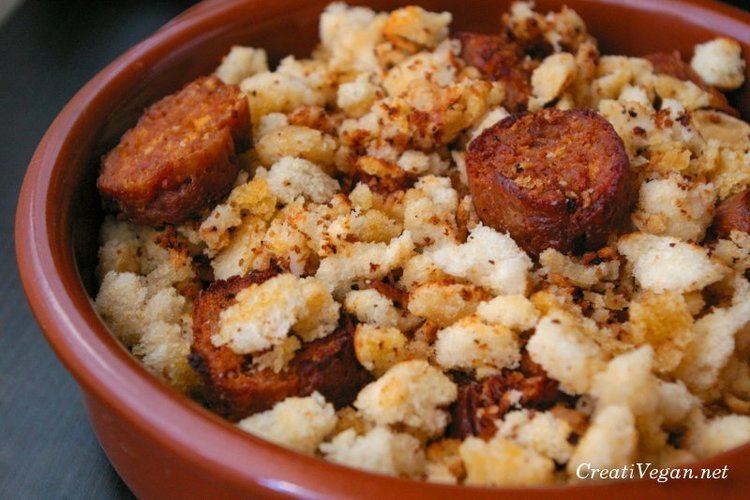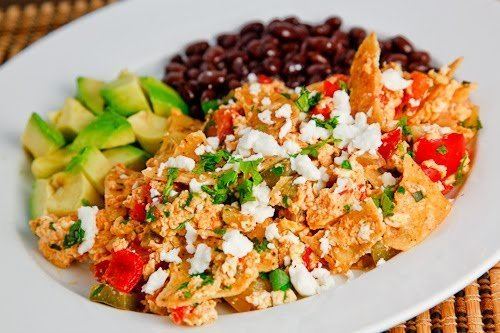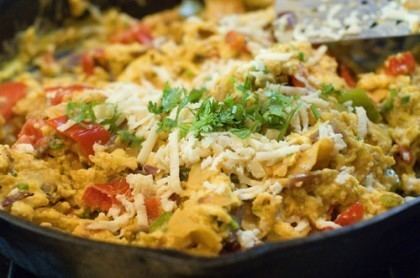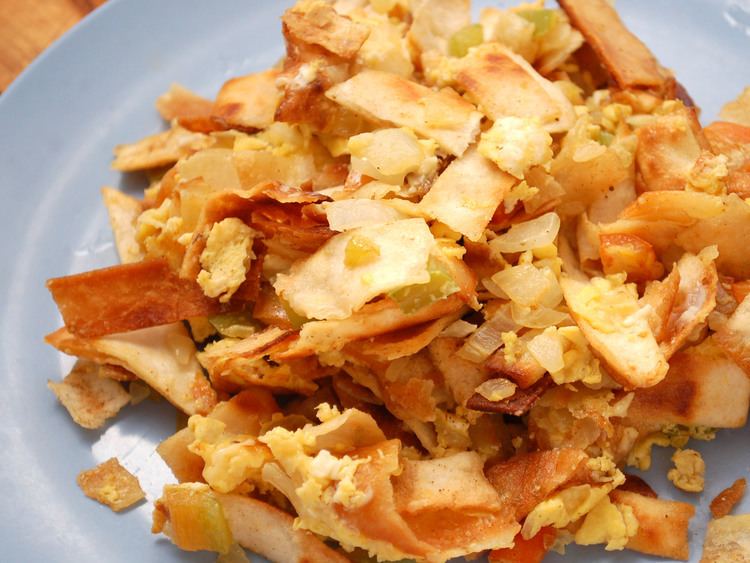Alternative names Migajas Serving temperature Warm | Course Appetiser Main ingredients Bread Main ingredient Bread | |
 | ||
Similar Bread, Sandwiches de miga, Bacalhau, Chorizo, Chilaquiles | ||
Migas ([ˈmiɣas]) ("crumbs" in English) is the name used for an ancient dish in Spanish and Portuguese cuisines.
Contents
- How to make migas mexican scrambled eggs hilah cooking ep 38
- Spanish migas
- Portuguese migas
- Mexican migas
- Mexico City migas
- Tex Mex migas
- References

The same name is used for a different dish in Mexican and Tex-Mex cuisines.
How to make migas mexican scrambled eggs hilah cooking ep 38
Spanish migas

Migas is a traditional dish in Spanish cuisine. Originally a breakfast dish that made use of leftover bread or tortas, today migas is a fashionable first course served for lunch and dinner in restaurants in Spain.

The ingredients of migas vary across the provinces of Spain. In Extremadura, this dish includes day-old bread soaked in water, garlic, paprika, and olive oil, and contains spinach or alfalfa, often served with pan-fried pork ribs. In Teruel, Aragon, migas includes chorizo and bacon, and is often served with grapes.
In La Mancha, migas manchegas is a more elaborate preparation using basically the same ingredients as Aragonese migas.

There is also a dish named migas related to couscous that uses flour and water, but no bread, and can be found in Andalusia.
Portuguese migas

Migas is also a traditional dish in Portuguese cuisine. It is usually made with leftover bread, either wheat bread traditionally associated with the Alentejo region in Southern Portugal, or corn bread as used in Beira. In Alentejo migas can also be made with potatoes (Migas de Batata) and no bread is included.

Garlic and olive oil are always an ingredient. Other ingredients such as pork meat drippings, wild asparagus, tomato, and seasonings such red pepper paste and fresh coriander are usually included in Alentejo, while in Beira the other ingredients typically are cooked kale cut in caldo verde style, cooked beans (pinto or kidney beans) and sometimes cooked rice.
Migas usually accompanies meats or other main dishes.
Mexican migas
In different areas of Mexico, migas is a traditional breakfast dish consisting of corn tortilla strips fried on a pan or griddle until almost crispy and then eggs are added to create a scrambled egg/fried tortilla mixture. It is a traditional breakfast created due to the low-cost availability of eggs and the custom of buying small batches of corn tortillas daily. This made leftover corn tortillas from one day's lunch and dinner the next day's breakfast, but since day-old tortillas harden, they were best when cooked in oil along with other ingredients. The same reasoning gave rise to chilaquiles which is a similar meal, substituting salsa for eggs during cooking. Both are hearty, inexpensive and a traditional working-class breakfast meal.
Mexico City migas
Mexico City also has its own version of migas. It is a garlic soup which is thickened with sliced day-old bolillos. It is usually flavored with pork shanks, ham bones, epazote, oregano and different types of dried chillies. A raw egg is usually added to each plate when served and it is slowly cooked by the warm soup, similar to egg drop soup. It is a very popular dish in fondas around downtown Mexico city, especially in Tepito.
Tex-Mex migas
There is also a Tex-Mex variation of Mexican migas. This includes additional ingredients, such as diced onions, sliced chile peppers, diced fresh tomatoes, or cheese, as well as various spices and condiments (e.g., salsa or pico de gallo).
Migas is typically served with refried beans, and corn or flour tortillas may be used to enfold all of the ingredients into tacos. In some areas, it may have been traditionally eaten during Lent.
Another common variation is to add chorizo to the standard ingredients.
